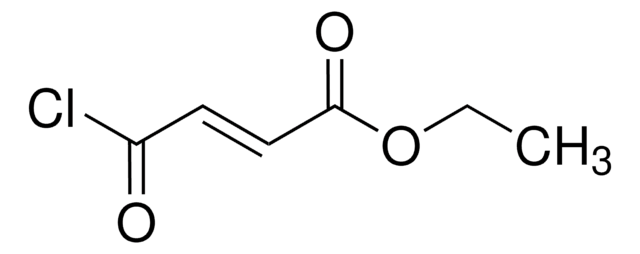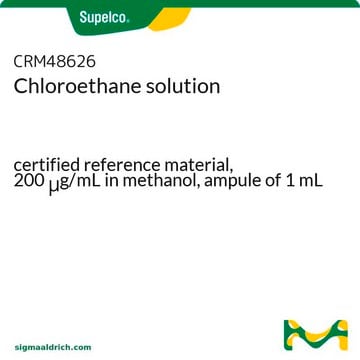Kluczowe dokumenty
338303
Chloroethane solution
2.0 M in tert-butyl methyl ether, anhydrous
Synonim(y):
Ethyl chloride
About This Item
Polecane produkty
klasa czystości
anhydrous
Poziom jakości
gęstość pary
2.22 (vs air)
ciśnienie pary
20.03 psi ( 55 °C)
5.98 psi ( 20 °C)
Formularz
liquid
temp. samozapłonu
966 °F
stężenie
2.0 M in tert-butyl methyl ether
zanieczyszczenia
<0.005% water
gęstość
0.775 g/mL at 25 °C
grupa funkcyjna
alkyl halide
chloro
temp. przechowywania
2-8°C
ciąg SMILES
CCCl
InChI
1S/C2H5Cl/c1-2-3/h2H2,1H3
Klucz InChI
HRYZWHHZPQKTII-UHFFFAOYSA-N
Szukasz podobnych produktów? Odwiedź Przewodnik dotyczący porównywania produktów
Powiązane kategorie
Opis ogólny
Zastosowanie
- Green solvent in biomaterial extraction: Research highlights the use of Chloroethane as an effective solvent for extracting lignin-containing nanocellulose fibrils from date palm waste, emphasizing its potential in enhancing the sustainability of biomaterial processing (Raza et al., 2024).
Opakowanie
Compatible with the following:
- Aldrich® Sure/Pac™ station for liquefied gases Z566446
- PTFE Sealing tape Z104388 or Z221880
- Straight septum-inlet adapter Z118141 with septa Z565687 or Z565695
Informacje prawne
adapter wlotu septy
najczęściej kupowane z tym produktem
polecane
Hasło ostrzegawcze
Danger
Zwroty wskazujące rodzaj zagrożenia
Zwroty wskazujące środki ostrożności
Klasyfikacja zagrożeń
Carc. 2 - Flam. Liq. 2 - Repr. 1B - Skin Irrit. 2
Kod klasy składowania
3 - Flammable liquids
Klasa zagrożenia wodnego (WGK)
WGK 2
Temperatura zapłonu (°F)
-29.2 °F - closed cup
Temperatura zapłonu (°C)
-34 °C - closed cup
Wybierz jedną z najnowszych wersji:
Masz już ten produkt?
Dokumenty związane z niedawno zakupionymi produktami zostały zamieszczone w Bibliotece dokumentów.
Nasz zespół naukowców ma doświadczenie we wszystkich obszarach badań, w tym w naukach przyrodniczych, materiałoznawstwie, syntezie chemicznej, chromatografii, analityce i wielu innych dziedzinach.
Skontaktuj się z zespołem ds. pomocy technicznej









